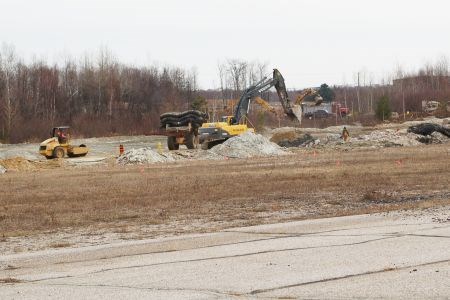With North Bay's industrial parks being full, the city is developing land around the airport to attract new commercial enterprises.
“There really is a need for industrial land,” said Rick Evans, manager of the Mayor's Office of Economic Development.
The industrial park in the Seymour Street area has been filled for about 15 years and only about 30 acres are left in the Gateway Industrial Park. There is also little industrial land available in the private sector, especially after the provincial government brought in a significant wetlands policy and about 600 acres were taken out of play.
“This has pressured us into the new Airport Industrial Business Park. It is our first experience doing a combined aerospace and industrial park and it has been a learning curve for us,” he said.
Currently, 115 fully serviced acres are being developed with 50 acres for groundside and 65 for airside. In preparation for the development, a new water tower near the airport terminal was erected last year at a cost of $7 million.
“There are some companies in the wings, including an airside one, and we should be able to reveal in the next six months who they are,” Evans said.
With the downsizing of CFB North Bay several years ago, several military hangars were left empty. That led to the development of the city's Aerospace Centre which hosts Bombardier's Canadair 415 water bomber assembly line, Voyageur Airways, Canadore College's School of Aviation and various helicopter flight training schools.
The military's legacy also includes a 10,000-foot runway, which can accommodate planes such as a Boeing 747 and Antonov 124.
Eventual plans include extending Four Mile Lake Road to connect with Highway 11 via Marsh Drive to keep industrial traffic off Airport Road.
“Heavy traffic on (Airport Road) is not good planning so certainly in the next three to five years we can see that extension opening up,” Evans said.
The new industrial park also has a unique feature on the airside lots – they can be purchased or leased.
“Conventionally, you don't sell airside property. It is not done in the U.S. at all and in very few places in Canada. Here, you can, and it is the choice of the client,” he said.
When Transport Canada owned the airport, airside property could only be leased. That often created challenges with prospective businesses seeking financing when full security, including land, was required.
“It's an option here and we will see how it plays out,” Evans said. “It is a marketing tool that is attractive.”
Developing an industrial park within the area of an operational airport adds new dimensions that the city must now consider.
“NAV CANADA approvals are now part of the process even though we own the land. We have an airport board and we work with them and an airport manager who is responsible for the operational side of the airport,” he said. “We do all the marketing but land transactions, whether they are sale or lease, are just a bit more complicated than they were for the other parks.”
There are advantages for businesses to be located near an airport. While it is more convenient for air travel, many companies have components being shipped in and out as well.
“What I think will happen, over time, is that warehousing distribution will be established at that park,” he said.
There are also advantages for tenants through the Airport Community Improvement Plan which offers targeted incentive initiatives for new builds, expansions or improvements to city-approved developments at the airport park.
These include a refund of the municipal portion of property tax associated with the improvements with 100 per cent of the increase the first year, 66 per cent in the second and 33 per cent in the third year. Industrial development charges are waived and municipal planning, legal and building permit fees are refunded. Landfill tipping fees associated with site preparation are also reduced.
Companies the city tends to deal with are smaller footprint niche players with a higher degree of engineering in their products and services.
“Back 30 years ago, we had big footprint companies like Fabrene, which is still our largest industrial manufacturer, and Dupont, but it is not likely you will see another big plant come in. The size we would expect is 20,000 to 80,000 square-foot operations,” Evans said.
The Airport Industrial Business Park has a total of 255 acres of airside land and 373 acres of groundside land available for development. Divided into quadrants, there is ample room for growth once the current lots are filled.
“It really is exciting with the future of the city and where it is going. We are well positioned for growth,” Evans said.




